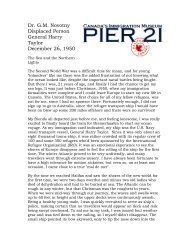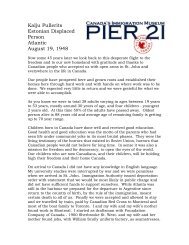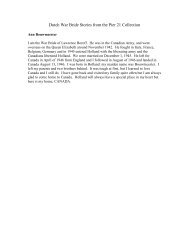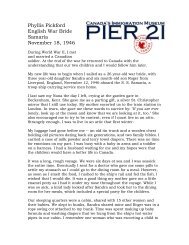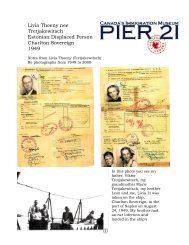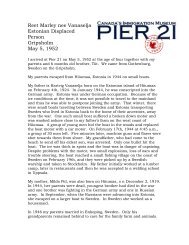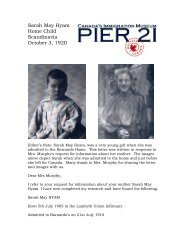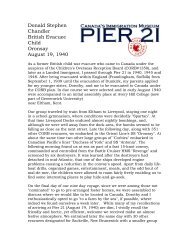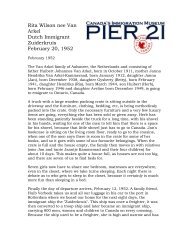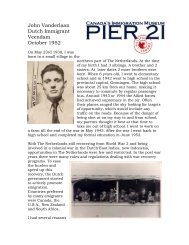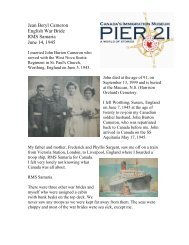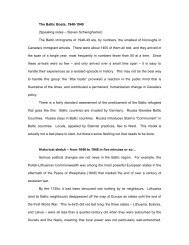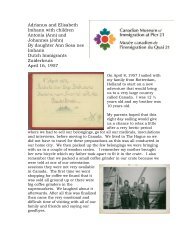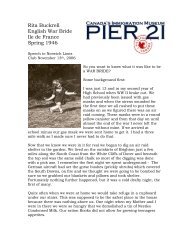Dutch and German Immigrants The Prins Family - Pier 21
Dutch and German Immigrants The Prins Family - Pier 21
Dutch and German Immigrants The Prins Family - Pier 21
You also want an ePaper? Increase the reach of your titles
YUMPU automatically turns print PDFs into web optimized ePapers that Google loves.
Every year, in the late part of the summer, the greengrocer came by withcrates filled with green <strong>and</strong> slicing beans. Everyone in sight was enlistedto snip off bean-ends, breaking or slicking beans, after which they weresalted away in wooden barrels <strong>and</strong> stored in the basement for later use.I also remember the “kant” (quay) <strong>and</strong> the harbour where the trawlersreturned from their fishing trips. After unloading their catch of fish, theywere pulled to the other side of the harbour, refitted again with ice, coal<strong>and</strong> victuals (<strong>and</strong> a few bottles of liquor I suppose), <strong>and</strong> made readyagain for another fishing trip lasting 10-12 days.Opa <strong>Prins</strong>, in his earlier days, owned more than then trawlers, butduring <strong>and</strong> after the depression quite a few were sold for scrap. I stillremember that he had six or seven, but that number had been reducedto two when the war started. His office was located on the quay with awarehouse <strong>and</strong> a machine shop. Anotehr warehouse close to the otherharbour (<strong>The</strong> Haringhaven) was destroyed in the war during an Allied airaid.Opa had two employees working in the warehouse fixing fishing nets <strong>and</strong>doing other jobs. In the corner of the yard was a liquid tar pit used tosoak the fishing nets. I never found out how deep that pit was but I wasalways scared to fall in <strong>and</strong> kept my distance. Thinkin gof it now, it stillscares me. When it was quitting time I made sure to be out of thebuilding so I wouldn’t be locked in. <strong>The</strong>re were wonderful objects storedin the warehouse, from lanterns to cork balls <strong>and</strong> wooden loadingchutes. Uncle Jack once used a chute to make a beach sailing boat, itsure went fast.<strong>The</strong> two trawlers Opa still owned when the war started were the Perseus<strong>and</strong> the Penelope. <strong>The</strong> Penelope was built by Hellyer’s Bros. In 1895 inHull Engl<strong>and</strong> <strong>and</strong> was bought by Opa’s company the Praxis in 1911.During the war she stayed in Ijmuiden <strong>and</strong> started fishing again July 17,1941, under strict control of the <strong>German</strong> occupying forces. <strong>The</strong>se shipsoften came under attack from the RAF <strong>and</strong> accidents did happen. <strong>The</strong>Penelope left Ijmuiden for the last time on January 31 1942. <strong>The</strong> nextday she was attacked <strong>and</strong> sunk. According to the book description,Master Frans van der Kuil (husb<strong>and</strong> of Aunt Antje) perished with hisship but according to Klaar, he survived that attack with a h<strong>and</strong> wound.<strong>The</strong> Perseus, built by Welton & Gemmell & Cook in 1897, was bought bythe Praxis in 1911. This ship left Ijmuiden’s harbour on May 8, 1940,with the oldest Master Teun Groen in comm<strong>and</strong>. Two days later the<strong>German</strong>s invaded Holl<strong>and</strong> <strong>and</strong> ship <strong>and</strong> crew fled to Engl<strong>and</strong> <strong>and</strong>remained there during the five war years. <strong>The</strong>y continued fishing duringthose years with Fleetwood Engl<strong>and</strong> becoming their home harbour. After



